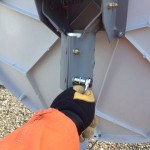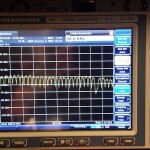Step 1 went fine with all the mechanical aspects and the antenna mounting. Now, time for some pointing activities !
The method we relied on mixes an empirical approach and some measurements. It does not require you to know your exact location as long as you are in the Northern hemisphere. Here is the hardware we used :

- A wrench
- A TV screen
- A DVB-S demodulator for TV broadcast
- A spectrum analyzer
- A two-way radio system (PMR446)
The team was also split in two groups : one person on the roof and the rest in front of the analyzer. By now, you may guess what the PMR446 is for.
And here is the method we used :

- Point the antenna roughly southwards, elevation “flat”
- Set the analyzer to “listen” to the LNB output on the L-band (say between 950 and 1250 MHz)
- Start slowly increasing the antenna elevation
- Check the analyzer screen for carriers to appear
- Keep increasing the elevation until the carriers power starts fading away (1)
- Decrease slightly the elevation to get back to the optimal elevation
- Do the same for the azimuth : turn eastwards or westwards to maximize the power received from the carriers
Now you are pointing to a satellite … but which one ? This is where the DVB-S tuner comes into play. Look for the TV channels that are available on the received satellite and check against a satellite TV programme on the Internet … guessing what is the received satellite should be pretty easy.
One you know where you are, it is simple to hop from one satellite to another (2), eventually reaching you target. Finish by adjusting again the elevation and the LNB tilt and … voilà !
Note (1) : you may want to inccrease the elevation further to make sure you did not hit a secondary lobe.
Note (2) : using a compass might help you to initially start closer to the target satellite. Careful adjustement is required considering that our 1.2 m dish features a 3 dB aperture of 1.5° on the Ku band.